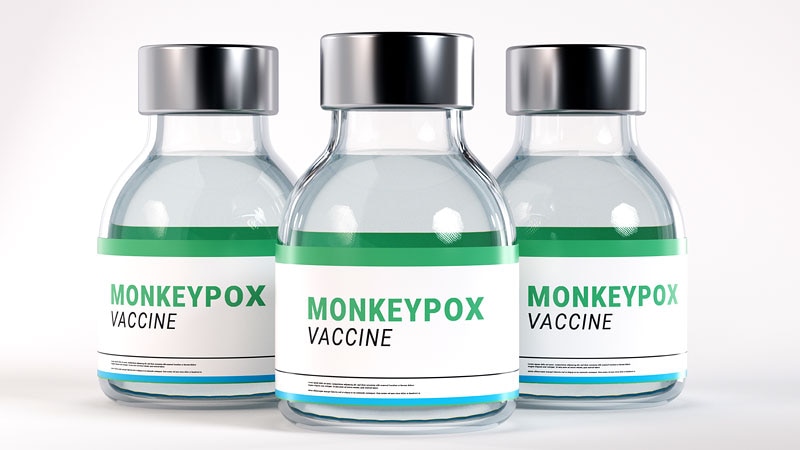A new mathematical model can guide public health policy makers on the most efficient way to use a limited supply of vaccines against monkeypox, data indicate.
Developed by a team of researchers at the University of Toronto, Toronto, Ontario, Canada, the model provides a blueprint for prioritizing the vaccines so that they go to the populations that need them the most.

Jesse Knight
“Understanding the drivers of an epidemic and the reasons why there may be differential risks across some populations allows us to efficiently prioritize our response, whether that is with vaccines or potentially other resources, to help people isolate at home, or access treatment,” lead author Jesse Knight, a PhD candidate at the University of Toronto, told Medscape Medical News.
The data were published online November 28 in Canadian Medical Association Journal.
Targeting Larger Networks
“In the context of infectious disease, the model allows us to predict how many infections we would expect to see under a particular combination of conditions. In this case, we explored a wide range of plausible conditions and then determined what would be the total number of infections under these conditions,” said Knight.

Dr Sharmistha Mishra
“When we think about a complex problem, where there are a lot of moving parts and a lot of things happening at once, mathematical models allow us to break the information down into simpler parts and to ask focused questions, which are hard to do in the real world,” senior author Sharmistha Mishra, MD, PhD, clinician scientist at the University of Toronto’s Li Ka Shing Knowledge Institute, told Medscape.
“We hope that the insights generated by the model can be applied by policy makers across diverse and dynamic epidemic contexts across Canada and beyond to maximize [the number of] infections averted early in an epidemic with limited vaccine supply,” said Mishra.
As of October 28, 2022, there were 1435 cases of monkeypox virus (MPXV) in Canada. The cases disproportionately affect gay, bisexual, and other men who have sex with men (GBMSM).
The limited supply of MPXV vaccine prompted the researchers to explore optimal vaccine allocation between two partially linked GBMSM transmission networks in two hypothetical cities in Ontario — a large, urban city like Toronto, and a smaller city in another area of the province — with a combined GBMSM community size of 100,000.
The researchers varied the characteristics of the two cities across a range of plausible settings and simulated a rollout of 5000 vaccine doses over 30 days shortly after the first detected case of MPXV.
Under their modeling assumptions, they found that a limited MPXV vaccine supply could generally avert more early infections when prioritized to networks or cities that were larger, had more initial infections, or had the highest epidemic potential.
“If a larger city had greater epidemic potential and most of the initial cases, it was best to allocate the majority of the vaccines to that city,” said Knight.
Such models could theoretically be extended to other vaccine shortages for other diseases, he said.
“For example, when we think about global vaccine equity, to be able to have enough resources to get infections down where the potential for the epidemic is high is important overall,” said Mishra.
High-Risk Groups
Commenting on the study for Medscape, Stephen A. Hoption Cann, PhD, clinical professor at the University of British Columbia in Vancouver, Canada, said, “If you just hand the vaccine out to people who are gay, bisexual, and men who have sex with men, and there’s a limited supply, it’s probably not the best strategy.”

Stephen Hoption Cann PhD
The study offers another approach. “What the University of Toronto researchers are saying is that you have to look at who is at higher risk. So, if you have individuals who have multiple sexual partners over a short period of time, that’s a much higher risk group that you would want to prioritize over just offering the vaccine to the community in general. You want to focus on higher risk groups,” said Hoption Cann.
Monkeypox originated in Africa and largely spread in rural, forested areas, where it was transmitted from rodents to humans. In the 1970s, there was a small number of cases, but as the years progressed, the number of cases increased. By 2010 to 2020, there were 20,000 cases in Africa.
“We used to vaccinate against smallpox, but in the ’70s, we stopped vaccinating,” said Hoption Cann. “The younger population became vulnerable to monkeypox, but it wasn’t being sexually spread. But we’ve got 20,000 cases in Africa, so it is not unexpected that it would spread outside of Africa, but it is being sexually transmitted. And as we have found out, sexual transmission is a highly efficient way of spreading this disease.”
Monkeypox infections are continuing to spread and have become endemic, he added.
“The problem is that the numbers are so high in Africa that it is bound to spread to the rest of the world again, unless we prioritize vaccinating at-risk communities in Africa.”
The study was funded by University of Toronto Emerging and Pandemic Infections Consortium MPXV Collaborative Rapid Research Response and the Natural Sciences and Engineering Research Council of Canada. Knight, Mishra, and Hoption Cann reported no relevant financial relationships.
CMAJ. Published November 28, 2022. Full text.
For more Medscape Neurology news, join us on Facebook and Twitter.
Source: Read Full Article
